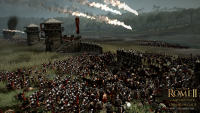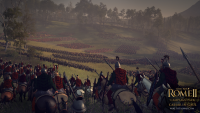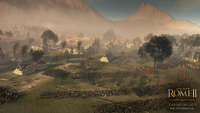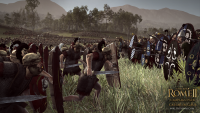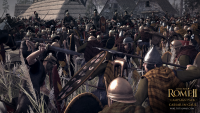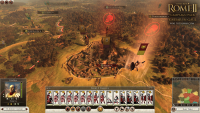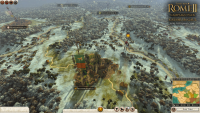Caesar in Gaul Campaign Pack
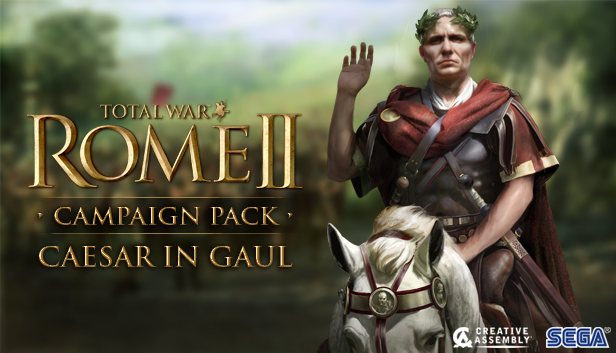
Caesar In Gaul - What is it?
Caesar in Gaul is a standalone campaign pack for Total War: ROME II covering Julius Caesar’s war of expansion against the Gaulish tribes. Players can choose from four playable factions in this conflict: the Gallic Arverni, the Germanic Suebi, the Belgic Nervii and Rome, in a campaign inspired by Caesar’s Commentarii de bello Gallico (Commentaries on the Gallic war).
Offering a tighter scope in terms of time and geography than Rome II (58-51BC), the Caesar in Gaul Campaign Map is an expanded, more detailed vision of Gaul and the south coast of Britannia.
Compared with ROME II’s map of Gaul, Caesar in Gaul contains more regions and provinces, more factions (both playable and non-playable), and a series of famous generals and statesmen from history which the player will employ or fight against depending on their chosen faction.
A war of great profit and glory for Caesar, this conflict made him extremely popular with the people of Rome… though less so with the senators, who saw him gathering power to himself in a series of events that ultimately lead to his ascension to Dictator.
Caesar in Gaul differs from the core ROME II experience in a number of important ways.
New Campaign Map
The Caesar in Gaul campaign map is an enhanced, more detailed representation of Gaul, with players able to expand across 18 provinces dotted with resources, new settlements and new provincial capitals.
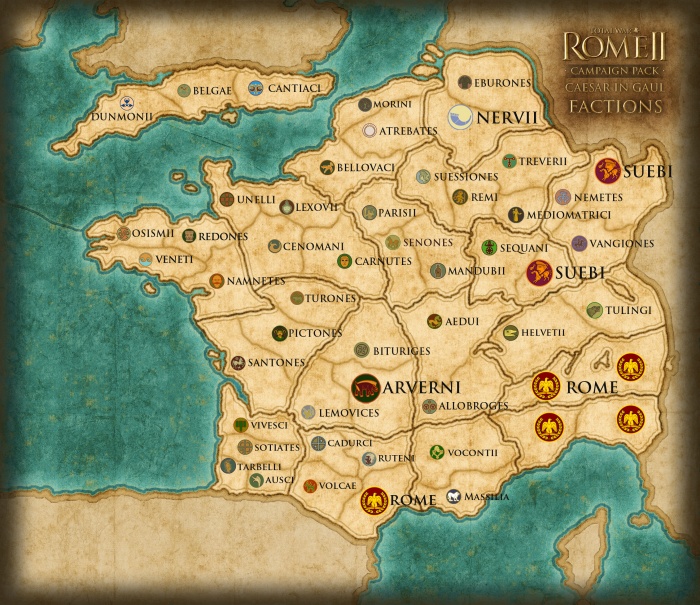
Greater focus on characters
Many factions employ great generals and statesmen from history (for example, Rome fields Gaius Julius Caesar himself, Mark Anthony and others). Each of the four playable factions also has a faction leader who acts as the player’s avatar during the campaign.
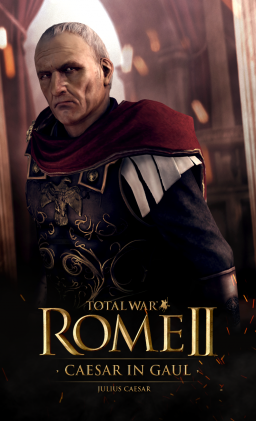
Julius Caesar was an ambitious Roman statesman and general who, while appearing to serve Rome's interests in containing the barbarian threat, was very much out to gain personal glory, wealth, and power. He extended the Roman Republic’s territory far north into Europe. After a string of military victories against the Germanic tribes and the Belgae, he took his legions and invaded Britannia – twice – before levelling his gaze on the real target of his ambitions: Gaul. In the eyes of the Roman people, his successes in northern Europe came to eclipse the reputation of his co-consul, Gaius Pompey Magnus. Ultimately Caesar’s campaign in Gaul enabled him to enter Rome under arms, instigate a civil war and proclaim himself dictator. But during his Gallic campaign, surrounded by restless natives and opposed on all sides, victory seemed far from assured…
Ariovistus
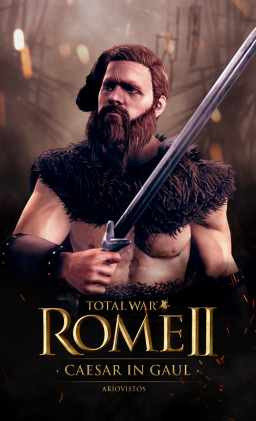
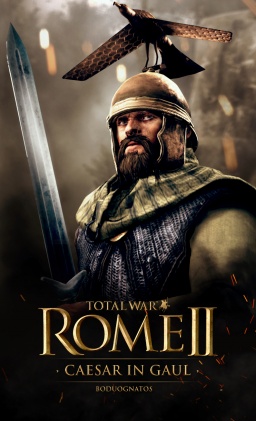
Under the pretence of protecting ‘friends of Rome’ – or more accurately, Rome’s puppet tribes – Caesar executed his campaign against the Suebi. Fearing the same fate might befall them, the Belgic tribes gathered under the banner of Galba, king of the Suessiones. After defeat by Caesar at Aisne however, the union collapsed, and just four tribes offered continued resistance to Roman expansion in the region. Among these were the fiercely independent tribe of the Nervii, led by the Belgic warlord Boduognatus. He would go on to lead a new alliance of Belgic forces against Caesar, culminating in the Battle of Sabis, in which he surprised many by coming within a whisker of defeating eight Roman legions.
Vercingetorix
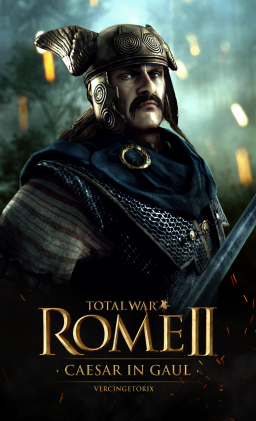
Seasons & 24 turns per year
As Caesar in Gaul deals with a considerably shorter time-span (58-51BC) than the grand sweep of the ROME II campaign, each turn represents two weeks rather than a year. This means seasons make a return. The gameplay effects of these aren’t always predictable however, and may vary from province to province. A late autumn may bring a good harvest for example, but a long, dry summer may damage your food production.
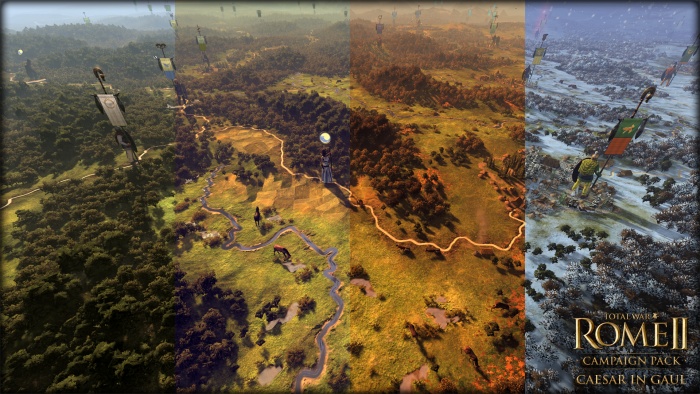
Compact, focussed multiplayer campaign
For those generals looking for a more rapid MP campaign game, Caesar in Gaul presents a series of interesting options. Due to the geographic scope and the opposing 48 factions, co-op or competitive 2-player campaigns are tighter, more focussed, and less time-consuming than a full Campaign.
New mid-game challenge mechanics
For those players making it through to the mid-game, there will be new challenges to face as a more suitable replacement for the Civil Wars of ROME II. As a Gallic tribe, you’ll feel the mailed fist of Rome respond with heavy intervention forces, and as Rome, you’ll see the Gallic tribes rebelling and forming alliances against you.
New historical battle - Alesia -
Caesar in Gaul adds the Battle of Alesia as a playable historical battle. Alesia marked the turning point of Caesar’s Gallic War, and resulted in the capture of Vercingetorix, who was later taken to Rome and executed at Caesar’s Triumph.
Set from Caesar’s perspective, Alesia tasks the player with maintaining the siege of Vercingetorix's Gallic stronghold. The battle begins with the Roman forces deployed within their own investment fortifications outside the hill-fort. The player must guide the Romans as they weather attacks from both a huge relief army and within the fort itself.
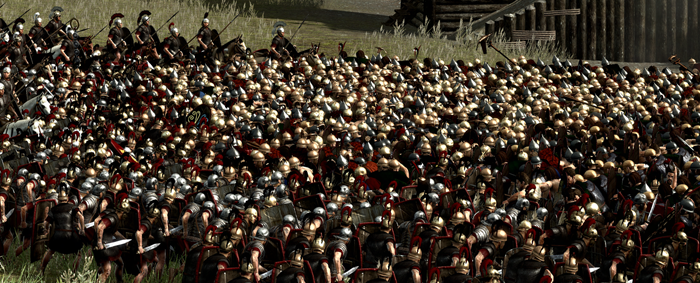
| Click on the picture above to display the Alesia Panorama |
New Total War: ROME II full campaign playable factions

|
One of the largest of the Gallic tribes, the Boii occupied Cisalpine-Gaul, Pannonia, Bohemia and Transalpine Gaul. Their numbers make them a force to be reckoned with but they are somewhat disconnected from other the Gallic tribes geographically and are directly exposed to the ferocious Germanic clans and the Dacians. |
| Read more about this faction |

|
The Gauls of the East, the Galatians migrated to Asia Minor following the Celtic invasion of the Balkans. They arrived through Thracia at around 270 BC, led by generals Lotarios & Leonnorios. As Celts deep within Hellenic territory and factions hostile towards them, the Galatians offer interesting and challenging new gameplay. |
| Read more about this faction |

|
The most fierce and powerful of the Belgic tribes, the Nervii are a melting pot of Celtic and Germanic heritage. Their unit roster reflects this mix of cultures, opening up the possibility of creating new, unique army compositions. |
| Read more about this faction |
New units
Alongside their usual unit rosters, the playable factions of Caesar in Gaul (and playable factions in the main ROME II campaign provided by Caesar in Gaul ownership) also gain the following new units:
- Boii (ROME II)
- Sword Followers (sword infantry) Where a lord commands, the sword is thrust.
- Veteran Spears (spear infantry) Battle hardens the sinews and the heart, and deafens the ear to the cries of cowards.
- Galatians (ROME II)
- Galatian Legionaries (sword infantry) The Celts have taught the Romans more than they're prepared to admit, but this is a two-way street.
- Galatian Raiders (javelin and sword cavalry) Broken enemies know it is better to flee than face riders who will not spare their lives.
- Gallic tribes (ROME II and Caesar in Gaul)
- Chosen Swordsmen (sword infantry) These men fight with proven bravery and well-honed skill-at-arms.
- Chosen Spearmen (spear infantry) Chainmail does not chill a warrior's heart, or still his lust for battle.
- Gallic Hunters (stealth bow infantry) The skills of the hunt, hiding and a sudden strike, are the skills of a warrior.
- Nervii (ROME II and Caesar in Gaul)
- Fierce Swords (sword infantry) Once he has earned it, a Celt will only be parted from his longsword by death itself.
- Guerilla Swordsmen (stealth sword infantry)
- These swordsmen strike wherever and whenever their enemies least expect.
- Mighty Horse (spear cavalry) A strong mount and a savage swing make these warriors a fearsome prospect.
- Naked Spears (spear infantry) Who needs clothes when you have more than your share of courage?
- Gallic Hunters (stealth bow infantry) The skills of the hunt, hiding and a sudden strike, are the skills of a warrior.
- Auxiliaries
- Auxiliary Gallic Hunters (stealth bow infantry) The skills of a hunter should be used in the service of Rome.
- Auxiliary Noble Horse(spear cavalry) A mounted, armoured fist is always useful in a Roman army.
- Auxiliary Naked Swords (sword infantry) The savage gods of war should be used to Rome's advantage.
- Auxiliary Short Swords (sword infantry) Bravery in battle, rather than skill, sometimes gives worth to a man.
- Mercenaries
- Mercenary Gallic Hunters (stealth bow infantry) The hunting of other men often has the greatest of rewards.
- Mercenary Noble Horse (spear cavalry) Even a nobleman has his price, and will fight for gold.
- Mercenary Naked Swords (sword infantry) The gods of war will bless mercenaries as long as they fight bravely.
- Mercenary Short Swords (sword infantry) It is often enough to sell bravery and a taste for glory.
Let's Play
System Requirements
Minimum
- OS: XP/ Vista / Windows 7 / Windows 8
- Processor: 2 GHz Intel Dual Core processor / 2.6 GHz Intel Single Core processor
- Memory: 2GB RAM
- Graphics: 512 MB DirectX 9.0c compatible card (shader model 3, vertex texture fetch support).
- DirectX®: 9.0c
- Hard Drive: 35 GB HD space
- Additional: Screen Resolution - 1024x768
Recommended
- OS: Windows 7 / Windows 8
- Processor: 2nd Generation Intel Core i5 processor (or greater)
- Memory: 4GB RAM
- Graphics: 1024 MB DirectX 11 compatible graphics card.
- DirectX®: 11
- Hard Drive: 35 GB HD space
- Additional: Screen Resolution - 1920x1080
